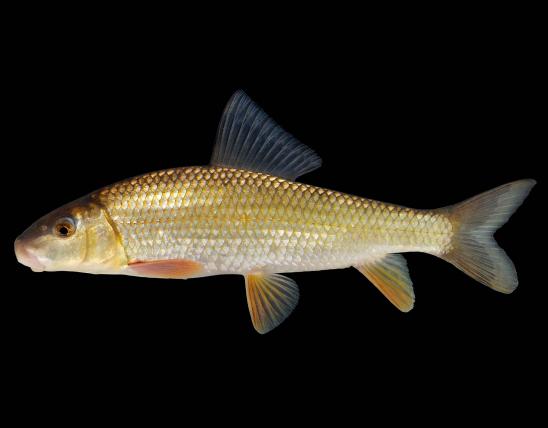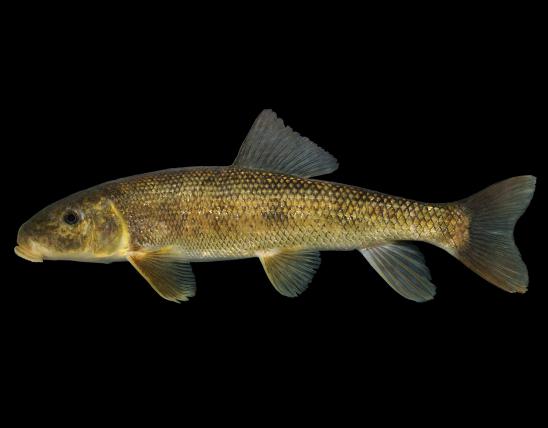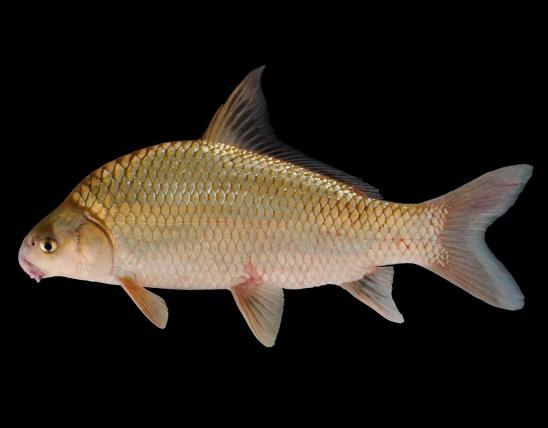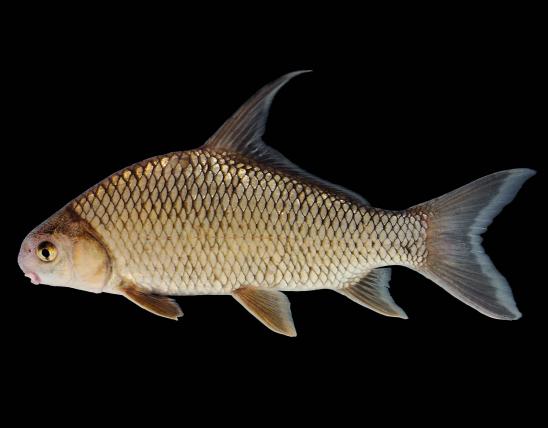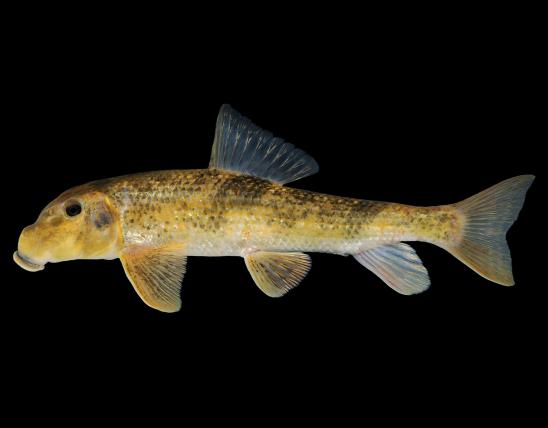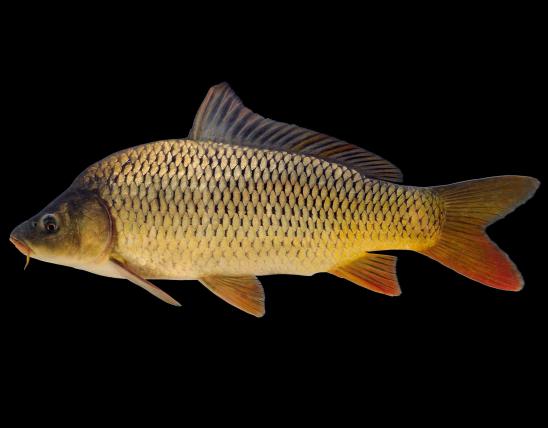
The river redhorse is a moderately chubby, coarse-scaled sucker with a short dorsal fin. The lower lips are broken up into parallel folds. The rear margin of the lower lip forms a slight V-shaped angle. The scales of the back and upper sides each have an indistinct crescent-shaped dark spot at the base. The base of the tail fin has a thin pencil-line of black along the hind margin of the last row of scales. The tail fin is bright red in life, and the upper lobe of the tail fin is often slightly longer and more pointed than the lower lobe.
Overall coloration: Back and upper sides olive brown with golden reflections, the scales rather prominently dark edged; remainder of sides a rich golden yellow. Belly white. Dorsal fin olive or slate; tail fin bright red; lower fins plain or with orange tinge.
Breeding males have small tubercles on the head, body, and fins, with these best-developed on the snout and cheeks.
More characters: Dorsal fin contains 12 or 13 (rarely 14) rays. The lateral line is complete, with 41–46 scales. The outer margin of the dorsal fin is straight or slightly curved outward (convex). The throat teeth on the lower half of the first arch are few in number, broad and molar-like, and with flattened grinding surfaces. The air bladder has 3 chambers.
Similar species: Overall, the coloration is similar to the shorthead redhorse. The shorthead redhorse, however, has the rear margin of the lower lip nearly straight; has a shorter head (its length, from tip of snout to outer edge of gill, goes 4.5 times or more into the standard length, from tip of snout to base of tail); has the upper lip often with a pea-shaped swelling at the middle; and has the throat-teeth arch thin, with slender teeth in comb-like series (not thick, with molar-like teeth).
Adult length: commonly 10½–22 inches; weight: commonly ½–4 pounds. Length and weight in Missouri streams seldom exceeds 26 inches and 8¼ pounds. Record weights are about 17 pounds.
Occurs throughout the Ozarks but is seldom common. In many Ozark streams, it is exceeded in abundance by all other redhorse suckers except the silver redhorse.
Habitat and Conservation
Occurs in Ozark streams: The river redhorse inhabits the pools of clear, medium-sized to large streams having gravelly or rocky bottoms and continuous strong flow. It seems less tolerant of turbidity, siltation, and intermittent flow than other redhorse suckers found in Missouri.
Food
The large, molar-like throat teeth that distinguish the river redhorse from other Missouri redhorse species are an adaptation for crushing the shells of mollusks. Indeed, the diet consists mostly of mollusks, especially the Asiatic clam Corbicula. This clam is not native to the Ozarks, and prior to its introduction, river redhorse in our streams probably fed principally on snails and the young of native freshwater mussels.
Status
Elsewhere in its range, the river redhorse has undergone substantial declines in abundance, but in the Ozarks there have been no apparent changes in its distribution and abundance for the last half of the 20th century. However, nothing is known of its abundance in Missouri prior to 1940.
Life Cycle
The river redhorse begins spawning in the Ozarks in early April, a little earlier than the black redhorse, with spawning preceded by upstream movements. According to an Alabama study, males arrive in spawning areas ahead of the females and excavate depressions 4–8 feet across and 8–12 inches into the gravel. Two males accompany the female in the spawning act. Vigorous vibrating motions by the spawning fish mix the eggs into the gravel. Growth is slower in Ozark streams than it is for other redhorse species during the first few years of life, but eventually the river redhorse overtakes and then surpasses the other species. The maximum life span in Missouri is at least 12 years.
Human Connections
Although the river redhorse is less abundant in Ozark streams than some other large suckers, it is much sought after because of its larger average size. It is most often taken by snagging or gigging but is also caught on hook and line using the flesh of mussels (clams) as bait.
In regions where this species has declined, habitat fragmentation and disruption seem to be the principal causes. This species cannot tolerate siltation, high turbidity, and pollution. Its presence or absence in a stream is one indicator of the stream’s health.
Ecosystem Connections
The Asian clam that has become the primary food of the river redhorse is an exotic invasive species. It was first discovered in our nation in the 1930s. Like other invasives, this clam contributes to the decline and replacement of native species, especially our native freshwater mussels, which apparently were the river redhorse’s ancestral food. Missouri has about 70 species of native mussels, which is an incredibly rich diversity for this remarkable but little-seen group. Of these, nearly 42 percent (29 species) are listed as Species of Conservation Concern, and 14 of the 29 are in danger of extirpation from Missouri or of complete extinction. Our native mussels are sensitive to water quality degradation and alteration of physical habitat. Creation of impoundments and other disruptions to flow, temperature, water chemistry, and sediments have decreased their populations. Meanwhile, the Asian clam out-reproduces and outcompetes our native mussels for food and space. Also, large die-offs of Asian clam can poison native mussels by increasing ammonia levels.

























